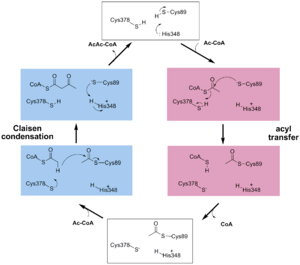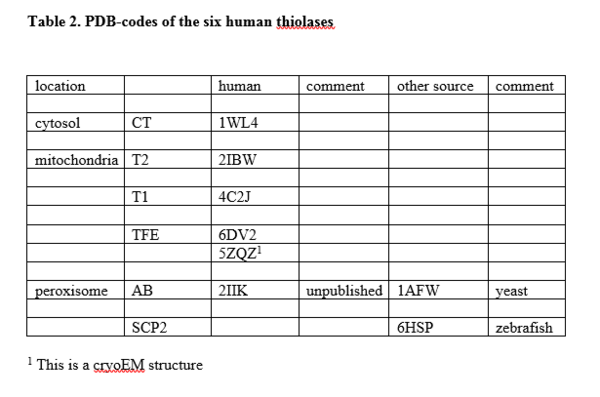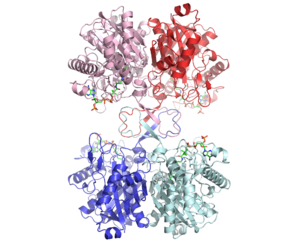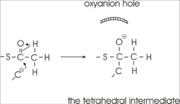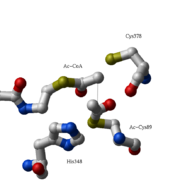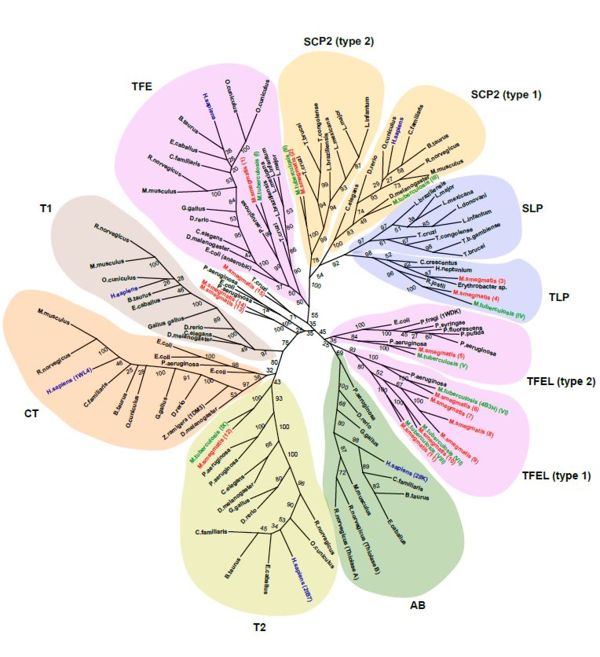Bacterial thiolase
From Proteopedia
(Difference between revisions)
| (40 intermediate revisions not shown.) | |||
| Line 1: | Line 1: | ||
'''3D structure (1DM3) of the bacterial ''Zoogloea ramigera'' biosynthetic thiolase''' | '''3D structure (1DM3) of the bacterial ''Zoogloea ramigera'' biosynthetic thiolase''' | ||
| - | <StructureSection load=' | + | <StructureSection load='' size='340' side='right' caption='Bacterial ''Zoogloea ramigera'' biosynthetic thiolase [[1dm3]]'' scene='40/403207/1dm3_rotating/2'> |
== Introduction == | == Introduction == | ||
| Line 7: | Line 7: | ||
pathway, also known as the β-oxidation pathway. However, in the human | pathway, also known as the β-oxidation pathway. However, in the human | ||
metabolism at least six thiolases (Table 1) have been | metabolism at least six thiolases (Table 1) have been | ||
| - | characterized. Each of them important in different pathways, and in | + | characterized. For most of these thiolases the structures are known (Table 2). Each of them important in different pathways, and in |
different cell organelles. Some thiolases are dimers, some thiolases are | different cell organelles. Some thiolases are dimers, some thiolases are | ||
tetramers, being dimers of dimers. Thiolases are involved, either in | tetramers, being dimers of dimers. Thiolases are involved, either in | ||
| - | degradative pathways (E.C. 2.3.1.16), or in biosynthetic pathways | + | degradative pathways (T1, AB, TFE: E.C. 2.3.1.16 or SCP2: E.C. 2.3.1.176) (<ref>PMID:30573650</ref>, or in biosynthetic pathways |
| - | (E.C. 2.3.1.9). This division is somewhat arbitrary as all thiolases | + | (T2, CT: E.C. 2.3.1.9). This division is somewhat arbitrary as all thiolases |
are sequence related to each other and catalyse the reaction in both directions. | are sequence related to each other and catalyse the reaction in both directions. | ||
| Line 64: | Line 64: | ||
|} | |} | ||
| - | + | [[Image:Table-2-for-proteopedia-new2.PNG|left|thumb|600px]] | |
== The reaction mechanism == | == The reaction mechanism == | ||
| Line 78: | Line 78: | ||
site geometry: a Asn316-Wat82 dyad, together with His348 make <scene name='User:Satyan_Sharma/Sandbox_1/Oxyanionhole_1/2'>oxyanion hole 1</scene>, stabilizing the CoA-thioester enolate intermediate. The hydrogen bond donors of oxyanion hole 1 are Wat82 and NE2 (His348). This enolate is formed from acetyl-CoA after proton | site geometry: a Asn316-Wat82 dyad, together with His348 make <scene name='User:Satyan_Sharma/Sandbox_1/Oxyanionhole_1/2'>oxyanion hole 1</scene>, stabilizing the CoA-thioester enolate intermediate. The hydrogen bond donors of oxyanion hole 1 are Wat82 and NE2 (His348). This enolate is formed from acetyl-CoA after proton | ||
abstraction by the catalytic base, Cys378 (Figure 3). | abstraction by the catalytic base, Cys378 (Figure 3). | ||
| - | <applet load='1dm3' size='300' frame='true' align='right' caption='The bacterial biosynthetic thiolase showing the acetyl CoA complex with sulfate: [[1DM3]], resolution 2.00 Å.'/> | ||
| Line 142: | Line 141: | ||
structural enzymology<ref name="merilainen" /> has confirmed that the CNH-triad of | structural enzymology<ref name="merilainen" /> has confirmed that the CNH-triad of | ||
''Zoogloea ramigera'' is indeed important for the function of oxyanion | ''Zoogloea ramigera'' is indeed important for the function of oxyanion | ||
| - | hole 1. | + | hole 1. These fingerprint sequences are in loops close to the active site. The catalytic base, Cys378 in the ''Zoogloea ramigera'' thiolase is in a fourth catalytic loop, and in most thiolases this is part of a conserved CxG-motif, except in the SCP2-thiolase subfamily <ref>PMID:30573650</ref>. More recently a sequence alignment using 130 thiolase and thiolase-like sequences |
| - | </StructureSection | + | (SLPs and TLPs) has been reported<ref name="tuberculosis">PMID:24825023 </ref>. The phylogenetic tree calculations using this sequence alignment groups these sequences in several clusters, as shown in Figure 6. Each of the observed sequence clusters has |
| + | a unique combination of the four sequence fingerprints. | ||
| + | |||
| + | [[Image:Figure-3-tuberculosis.jpeg|left|thumb|600px | Figure 6. The clustering of thiolase sequences into 11 clusters, using 130 thiolase sequences <ref name="tuberculosis"/> (this figure is copyright protected https://www.journals.elsevier.com/tuberculosis ; permission for publication on this website has been obtained).]] | ||
| + | |||
| + | </StructureSection> | ||
==Additional Resources== | ==Additional Resources== | ||
For additional information, see: [[Metabolic Disorders]] | For additional information, see: [[Metabolic Disorders]] | ||
Current revision
3D structure (1DM3) of the bacterial Zoogloea ramigera biosynthetic thiolase
| |||||||||||
Additional Resources
For additional information, see: Metabolic Disorders
3D structures of Thiolase
References
- ↑ Kiema TR, Thapa CJ, Laitaoja M, Schmitz W, Maksimainen MM, Fukao T, Rouvinen J, Janis J, Wierenga RK. The peroxisomal zebrafish SCP2-thiolase (type-1) is a weak transient dimer as revealed by crystal structures and native mass spectrometry. Biochem J. 2018 Dec 20. pii: BCJ20180788. doi: 10.1042/BCJ20180788. PMID:30573650 doi:http://dx.doi.org/10.1042/BCJ20180788
- ↑ Williams SF, Palmer MA, Peoples OP, Walsh CT, Sinskey AJ, Masamune S. Biosynthetic thiolase from Zoogloea ramigera. Mutagenesis of the putative active-site base Cys-378 to Ser-378 changes the partitioning of the acetyl S-enzyme intermediate. J Biol Chem. 1992 Aug 15;267(23):16041-3. PMID:1353760
- ↑ 3.0 3.1 Kursula P, Ojala J, Lambeir AM, Wierenga RK. The catalytic cycle of biosynthetic thiolase: a conformational journey of an acetyl group through four binding modes and two oxyanion holes. Biochemistry. 2002 Dec 31;41(52):15543-56. PMID:12501183
- ↑ 4.0 4.1 4.2 Merilainen G, Poikela VM, Kursula P, Wierenga RK. The thiolase reaction mechanism: the importance of Asn316 and His348 for stabilizing the enolate intermediate of the Claisen condensation. Biochemistry. 2009 Oct 20. PMID:19842716 doi:10.1021/bi901069h
- ↑ 5.0 5.1 Fukao T, Nguyen HT, Nguyen NT, Vu DC, Can NT, Pham AT, Nguyen KN, Kobayashi H, Hasegawa Y, Bui TP, Niezen-Koning KE, Wanders RJ, de Koning T, Nguyen LT, Yamaguchi S, Kondo N. A common mutation, R208X, identified in Vietnamese patients with mitochondrial acetoacetyl-CoA thiolase (T2) deficiency. Mol Genet Metab. 2010 May;100(1):37-41. Epub 2010 Jan 21. PMID:20156697 doi:10.1016/j.ymgme.2010.01.007
- ↑ Modis Y, Wierenga RK. Crystallographic analysis of the reaction pathway of Zoogloea ramigera biosynthetic thiolase. J Mol Biol. 2000 Apr 14;297(5):1171-82. PMID:10764581 doi:10.1006/jmbi.2000.3638
- ↑ Haapalainen AM, Merilainen G, Wierenga RK. The thiolase superfamily: condensing enzymes with diverse reaction specificities. Trends Biochem Sci. 2006 Jan;31(1):64-71. Epub 2005 Dec 13. PMID:16356722 doi:10.1016/j.tibs.2005.11.011
- ↑ Jiang C, Kim SY, Suh DY. Divergent evolution of the thiolase superfamily and chalcone synthase family. Mol Phylogenet Evol. 2008 Dec;49(3):691-701. Epub 2008 Sep 12. PMID:18824113 doi:10.1016/j.ympev.2008.09.002
- ↑ Kiema TR, Thapa CJ, Laitaoja M, Schmitz W, Maksimainen MM, Fukao T, Rouvinen J, Janis J, Wierenga RK. The peroxisomal zebrafish SCP2-thiolase (type-1) is a weak transient dimer as revealed by crystal structures and native mass spectrometry. Biochem J. 2018 Dec 20. pii: BCJ20180788. doi: 10.1042/BCJ20180788. PMID:30573650 doi:http://dx.doi.org/10.1042/BCJ20180788
- ↑ 10.0 10.1 Anbazhagan P, Harijan RK, Kiema TR, Janardan N, Murthy MR, Michels PA, Juffer AH, Wierenga RK. Phylogenetic relationships and classification of thiolases and thiolase-like proteins of Mycobacterium tuberculosis and Mycobacterium smegmatis. Tuberculosis (Edinb). 2014 Jul;94(4):405-12. doi: 10.1016/j.tube.2014.03.003., Epub 2014 Apr 4. PMID:24825023 doi:http://dx.doi.org/10.1016/j.tube.2014.03.003
Proteopedia Page Contributors and Editors (what is this?)
Rik Wierenga, Joel L. Sussman, Michal Harel, Satyan Sharma, David Canner

